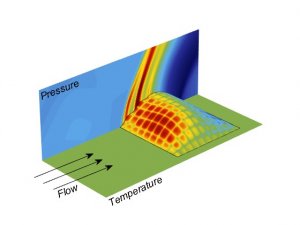Presented By: Aerospace Engineering
Chair's Distinguished Lecture Series - Harnessing Hypersonics: A Multi-Physics Frontier
Professor Jack J. McNamara, The Ohio State University

Jack J. McNamara
Professor
Director: Multi-Physics Interactions Research Group
Director: AFRL-University Collaborative Center in Structural Sciences
Mechanical & Aerospace Engineering
The Ohio State University
Recent technological advancements and expanding investments worldwide place us on the cusp of a hypersonics revolution. Yet the hypersonic environment remains largely untamed, and routine operations within it, elusive. Prominent issues are difficulty in comprehensively replicating the environment during testing and a broad set of potential multi-discipline interactions that are not sufficiently understood. These obfuscate nearly all aspects of hypersonic vehicle development, and often lead to underachievement in performance objectives, catastrophic failure, or cancelled programs. The structural system plays a key role in the future of hypersonics by impacting vehicle robustness, survivability, agility, guidance/control, and propulsion. In this context, established challenges on fluid-thermal-structural interactions are briefly reviewed. A more focused discussion is then provided on a long-standing problem: namely deep understanding and modeling of loads transmitted from a turbulent boundary layer to a compliant structure. Key points covered are characteristic parameters that dominate energy transfer, the degree of coupling between turbulence and an aerothermoelastic structure, and how to efficiently capture dominant interactions for relevant thermo-structural response scales.
About the speaker...
Jack J. McNamara is a professor in the Department of Mechanical & Aerospace Engineering at the Ohio State University. His research interests are broadly in the areas of computational fluid-structural interactions and model reduction of high-dimensional dynamical systems. A core application target is air vehicle operation in high-speed flow regimes, where there is a potential for complex interactions at both the component (fluid-thermal-structural-material) and vehicle (aero-servo-thermo-elastic-propulsive) levels. Other application areas include fluid-structural centric problems associated with ship airwakes, wind turbines, flapping wing air vehicles, automobiles, and turbomachinery. He is the director of the Multi-Physics Interactions Research Group at the Ohio State University and the seven-year AFRL-University Collaborative Center in Structural Sciences. The latter represents a partnership between the Air Force Research Laboratory Aerospace Systems Directorate, Ohio State University, Johns Hopkins University, Arizona State University, and University of Illinois Urbana-Champaign.
Professor
Director: Multi-Physics Interactions Research Group
Director: AFRL-University Collaborative Center in Structural Sciences
Mechanical & Aerospace Engineering
The Ohio State University
Recent technological advancements and expanding investments worldwide place us on the cusp of a hypersonics revolution. Yet the hypersonic environment remains largely untamed, and routine operations within it, elusive. Prominent issues are difficulty in comprehensively replicating the environment during testing and a broad set of potential multi-discipline interactions that are not sufficiently understood. These obfuscate nearly all aspects of hypersonic vehicle development, and often lead to underachievement in performance objectives, catastrophic failure, or cancelled programs. The structural system plays a key role in the future of hypersonics by impacting vehicle robustness, survivability, agility, guidance/control, and propulsion. In this context, established challenges on fluid-thermal-structural interactions are briefly reviewed. A more focused discussion is then provided on a long-standing problem: namely deep understanding and modeling of loads transmitted from a turbulent boundary layer to a compliant structure. Key points covered are characteristic parameters that dominate energy transfer, the degree of coupling between turbulence and an aerothermoelastic structure, and how to efficiently capture dominant interactions for relevant thermo-structural response scales.
About the speaker...
Jack J. McNamara is a professor in the Department of Mechanical & Aerospace Engineering at the Ohio State University. His research interests are broadly in the areas of computational fluid-structural interactions and model reduction of high-dimensional dynamical systems. A core application target is air vehicle operation in high-speed flow regimes, where there is a potential for complex interactions at both the component (fluid-thermal-structural-material) and vehicle (aero-servo-thermo-elastic-propulsive) levels. Other application areas include fluid-structural centric problems associated with ship airwakes, wind turbines, flapping wing air vehicles, automobiles, and turbomachinery. He is the director of the Multi-Physics Interactions Research Group at the Ohio State University and the seven-year AFRL-University Collaborative Center in Structural Sciences. The latter represents a partnership between the Air Force Research Laboratory Aerospace Systems Directorate, Ohio State University, Johns Hopkins University, Arizona State University, and University of Illinois Urbana-Champaign.